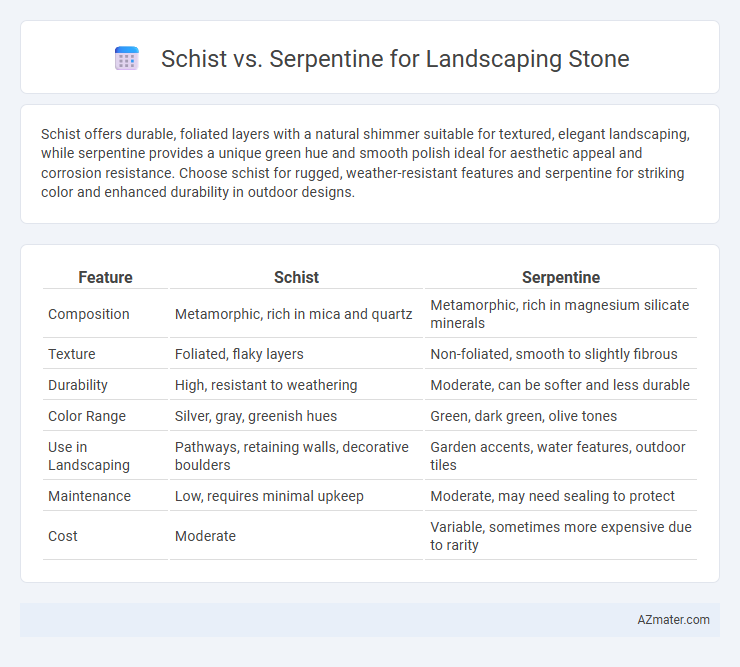Schist offers durable, foliated layers with a natural shimmer suitable for textured, elegant landscaping, while serpentine provides a unique green hue and smooth polish ideal for aesthetic appeal and corrosion resistance. Choose schist for rugged, weather-resistant features and serpentine for striking color and enhanced durability in outdoor designs.
Table of Comparison
| Feature | Schist | Serpentine |
|---|---|---|
| Composition | Metamorphic, rich in mica and quartz | Metamorphic, rich in magnesium silicate minerals |
| Texture | Foliated, flaky layers | Non-foliated, smooth to slightly fibrous |
| Durability | High, resistant to weathering | Moderate, can be softer and less durable |
| Color Range | Silver, gray, greenish hues | Green, dark green, olive tones |
| Use in Landscaping | Pathways, retaining walls, decorative boulders | Garden accents, water features, outdoor tiles |
| Maintenance | Low, requires minimal upkeep | Moderate, may need sealing to protect |
| Cost | Moderate | Variable, sometimes more expensive due to rarity |
Introduction to Schist and Serpentine Stones
Schist and serpentine are both popular choices for landscaping stone, each offering unique aesthetic and structural qualities. Schist, a metamorphic rock characterized by its foliated texture and visible mineral grains such as mica, quartz, and feldspar, provides a shimmering surface and excellent durability for garden paths and retaining walls. Serpentine, known for its smooth texture and vibrant green to dark green colors, is a magnesium-rich metamorphic rock that also offers resistance to weathering and a distinctive appearance ideal for decorative rock features and natural stone accents.
Geological Formation: Schist vs Serpentine
Schist forms through medium to high-grade regional metamorphism of sedimentary or igneous rocks, characterized by strong foliation due to the alignment of platy minerals such as mica. Serpentine originates from the hydration and metamorphic transformation of ultramafic rocks, primarily peridotite, resulting in a distinctive greenish, often fibrous texture. The contrasting geological formations influence their durability and aesthetic appeal, with schist's layered structure providing a unique texture and serpentine's mineral composition offering vibrant green hues for landscaping applications.
Visual Appearance and Color Variations
Schist offers a layered, flaky texture with a metallic sheen, featuring color variations from silver-gray to green and brown, creating a dynamic and natural look for landscaping. Serpentine showcases a smooth, often waxy surface with rich green hues, including dark olive to bright emerald, sometimes with mottled or veined patterns that add depth and elegance. Both stones enhance garden aesthetics, but Schist's rugged appearance contrasts with Serpentine's polished, vibrant tones.
Durability and Weather Resistance
Schist offers superior durability and weather resistance compared to serpentine, making it ideal for landscaping stones exposed to harsh environmental conditions. Its foliated structure allows it to withstand freeze-thaw cycles and resist erosion, ensuring long-term stability in outdoor settings. Serpentine, while visually appealing with its greenish hues, is softer and more susceptible to weathering, making it less suitable for high-traffic or exposed landscaping areas.
Workability and Installation Differences
Schist offers better workability for landscaping due to its foliated texture, allowing easier splitting and shaping into slabs or decorative pieces compared to serpentine's dense, harder composition that requires specialized tools for cutting. Installation of schist tends to be more straightforward as it can be split into uniform layers, providing consistent thickness for pathways and retaining walls, while serpentine's toughness demands more labor-intensive handling and anchoring methods. The durability and color variations in schist also enhance aesthetic appeal with less installation complexity than serpentine, which, despite its striking green tones, poses greater challenges for customization and precise placement.
Safety and Environmental Considerations
Schist is a durable metamorphic rock that poses minimal safety risks for landscaping, as it generally lacks harmful minerals and weathers steadily without releasing toxins. Serpentine, often containing asbestos minerals, raises significant health concerns due to potential airborne fibers during cutting or disturbance, making it less safe for residential landscaping. Environmentally, schist's extraction has a lower risk of soil and water contamination, while serpentine mining can impact local ecosystems adversely and requires careful management to prevent hazardous exposure.
Common Landscape Applications
Schist offers a coarse, flaky texture ideal for garden pathways, retaining walls, and decorative rock gardens due to its durability and aesthetic appeal. Serpentine features a smooth, often green-hued surface preferred for patio paving, water features, and accent stones where a unique color palette enhances the landscape design. Both stones provide erosion control benefits but cater to different visual and functional landscaping needs based on their mineral composition and weathering properties.
Cost Comparison and Availability
Schist landscaping stone generally costs more than serpentine due to its attractive glittering appearance and limited quarry sources. Serpentine is more widely available and tends to have lower prices because of larger deposits and easier extraction processes. Both stones offer durability, but budget-conscious projects often prefer serpentine for its cost-effectiveness and easier procurement.
Maintenance Requirements
Schist requires low maintenance due to its durability and resistance to weathering, making it ideal for long-lasting landscaping projects. Serpentine, while visually appealing with its rich green tones, demands more frequent care to prevent fading and surface deterioration caused by exposure to sunlight and moisture. Regular sealing of serpentine stones is essential to maintain their aesthetic appeal and structural integrity in outdoor environments.
Choosing the Right Stone for Your Landscaping Project
Schist and serpentine offer distinct advantages for landscaping projects; schist provides a durable, textured surface with its foliated, mineral-rich composition, ideal for pathways and accent walls. Serpentine, known for its rich green hues and smooth finish, adds a unique aesthetic appeal and resists weathering, making it suitable for garden features and decorative stone elements. Selecting between schist and serpentine depends on the desired visual texture, color palette, and environmental durability needed for your outdoor design.

Infographic: Schist vs Serpentine for Landscaping Stone
 azmater.com
azmater.com